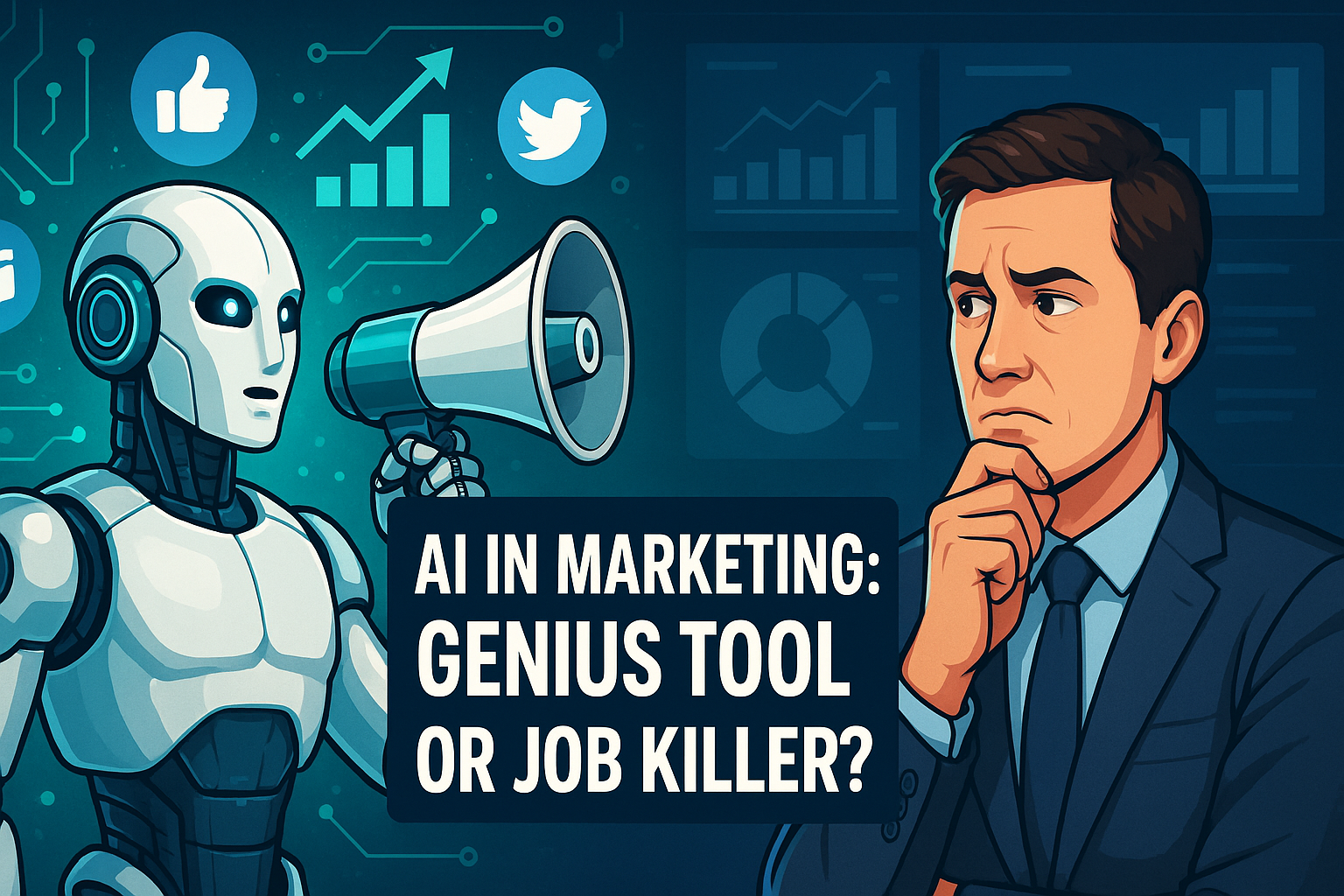The term AI in marketing has shifted from a buzzword to a core business strategy. Advances in machine learning and predictive analytics now enable precise audience targeting and real-time campaign optimization. In 2025, marketers face a clear question: “Is AI a genius tool or a job killer?” This post explores how AI tools can boost efficiency and creativity. It also addresses concerns about AI’s impact on marketing jobs.
What Is AI in Marketing?

AI in marketing means applying artificial intelligence such as machine learning, predictive analytics, chatbots, and personalization engines within marketing workflows. Machine learning algorithms find patterns in customer behavior. Predictive analytics forecasts trends to improve budget allocation. Chatbots handle routine customer inquiries and free human teams for strategic work. Typically, AI modules integrate into CRMs, marketing automation platforms, and ad networks. Consequently, these systems learn from new data and optimize campaigns in real-time.
Benefits of AI in Marketing as a Genius Tool
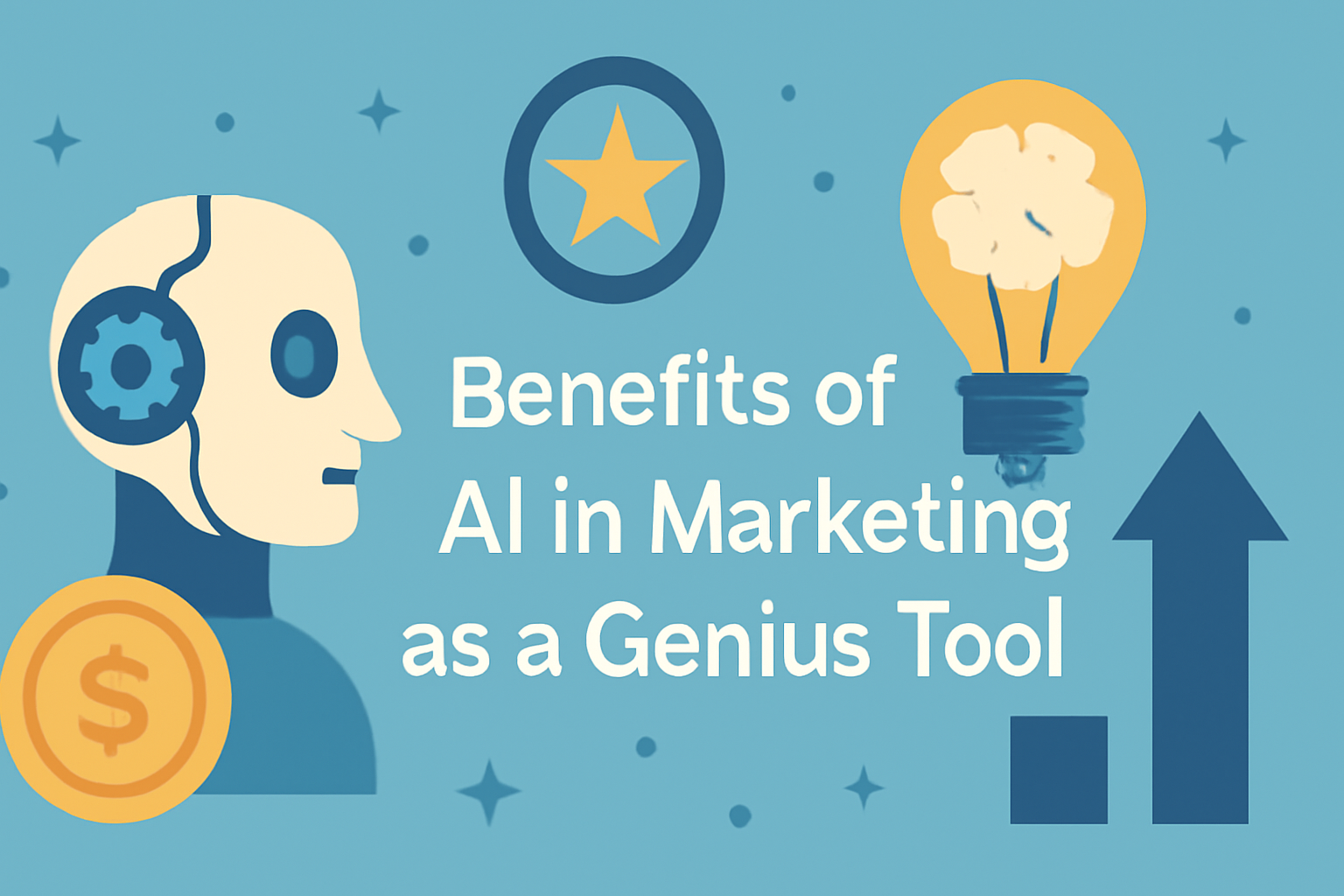
Data-Driven Customer Insights
AI processes large datasets to segment audiences and predict trends accurately. For instance, Salesforce Einstein uses AI-driven clustering to identify high-value customer groups. As a result, marketers can tailor messages more precisely. Furthermore, a SurveyMonkey study found that 75% of companies using AI for marketing shift toward strategic tasks. AI handles routine data analysis at scale. These insights help businesses predict churn. They also reveal opportunities to optimize products and forecast demand. Consequently, companies can cut wasted ad spend by up to 20%.
Automated Content and Campaign Creation
AI tools like Jasper AI and ContentShake AI generate email copy, ad creatives, and social media posts. They analyze brand voice and past performance data to do so. As a result, content ideation time drops by about 40%. Moreover, this approach lowers outsourcing costs. However, human review remains essential. It ensures consistency with brand tone and values. For example, Microsoft Advertising’s AI ad solutions boosted click-through rates by 25%. They achieved this by automating A/B tests and optimizing creatives in real-time.
Personalized Customer Journeys
AI-powered recommendation engines let e-commerce brands customize website content for individual visitors. Netflix’s AI personalization, for example, boosts viewer engagement. Similarly, retail systems can improve conversion rates by 15–20%. One online fashion retailer saw a 17% increase in average order value after adding AI-driven product suggestions to its homepage. Additionally, dynamic email campaigns that use predictive analytics send personalized offers. As a result, open rates rose by 27%, and revenue per email increased by 12%.
Concerns: Is AI a Job Killer in Marketing?
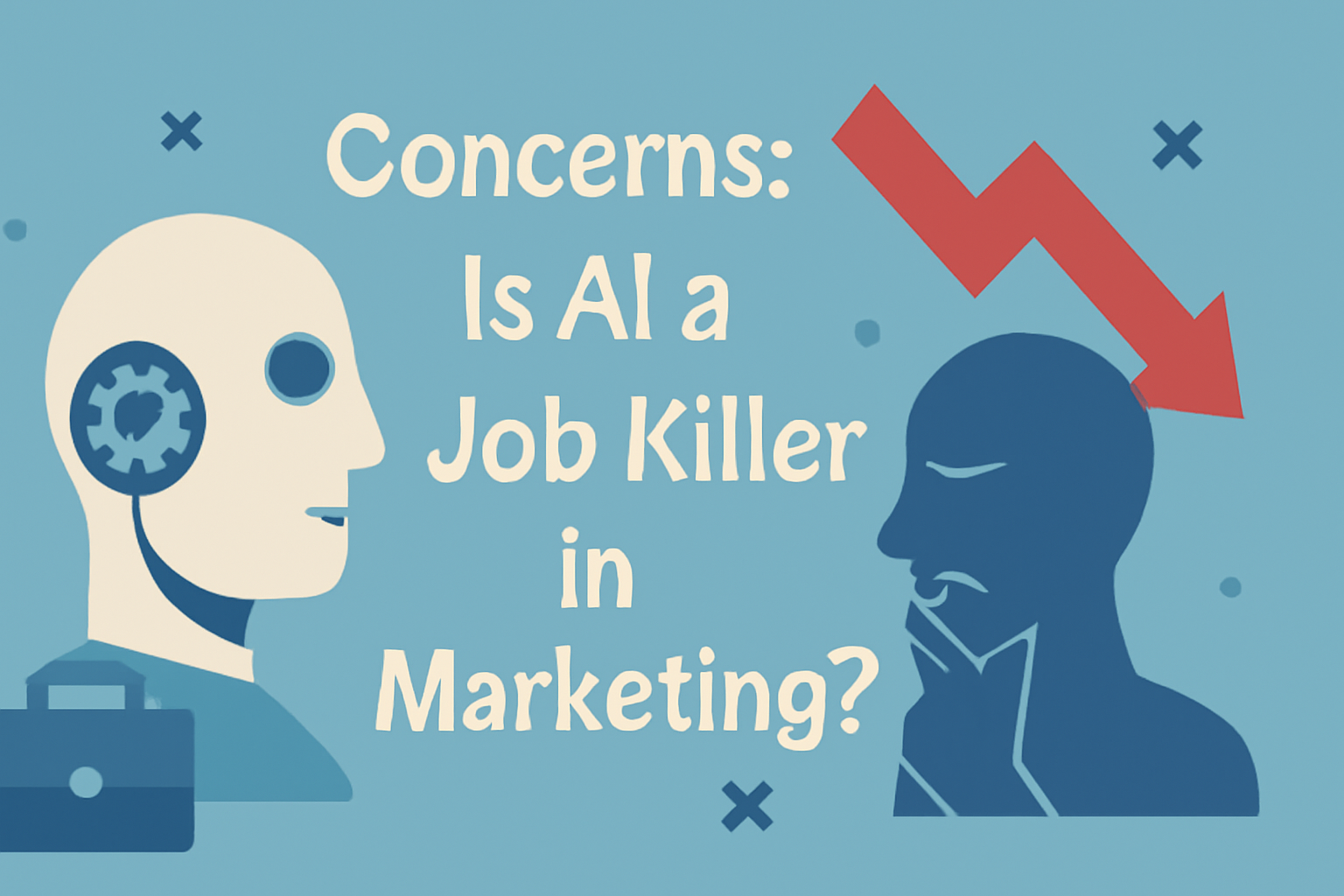
Automation vs. Human Creativity
Many fear AI will replace roles like copywriters and media buyers. Indeed, AI automates data-heavy tasks such as programmatic ad bidding and statistical analysis. Nevertheless, AI lacks the nuance of human creativity. Human teams still play a vital role in storytelling and setting strategic direction. Marketing leaders emphasize that AI should act as a collaborator. For example, ChatGPT can draft initial ideas. Then, humans refine messaging to match brand values and cultural context. In 2024, only 9% of marketing jobs were fully automated by AI. Meanwhile, 63% of marketers reported upskilling to work alongside AI tools.
Skills Marketers Need to Adapt
As AI grows in digital marketing, new skills become vital. First, marketers need AI literacy to understand model outputs. Second, data analysis skills help turn insights into action. Third, ethical oversight is crucial for spotting and fixing biases. Moreover, familiarity with tools like Google Analytics 4, HubSpot AI, and Adobe Sensei is increasingly important. Critical thinking helps marketers question AI recommendations and maintain brand authenticity. Recommended resources include Coursera’s AI for Everyone, Google’s AI certifications, and HubSpot Academy’s AI in Marketing course. Finally, soft skills such as collaboration, storytelling, and strategic planning remain critical as AI takes over routine tasks.
Real-World Examples: Success Stories & Failures
Success Story:
A leading apparel brand used an AI marketing automation platform to analyze purchase history and browsing behavior. With these insights, they sent hyper-personalized email campaigns to specific segments. As a result, email open rates rose by 22%, and email revenue grew by 18% within three months.
Failure Story:
Conversely, a major telecom company launched an AI chatbot without proper training on brand guidelines. Consequently, the chatbot provided incorrect product information and frustrated customers. This misstep led to a 5% increase in negative service feedback and a $200,000 loss in potential sales over two weeks.
These examples show that AI can deliver significant ROI. However, success hinges on careful implementation, continuous monitoring, and a strong feedback loop to avoid costly errors.
Ethical Considerations and Best Practices
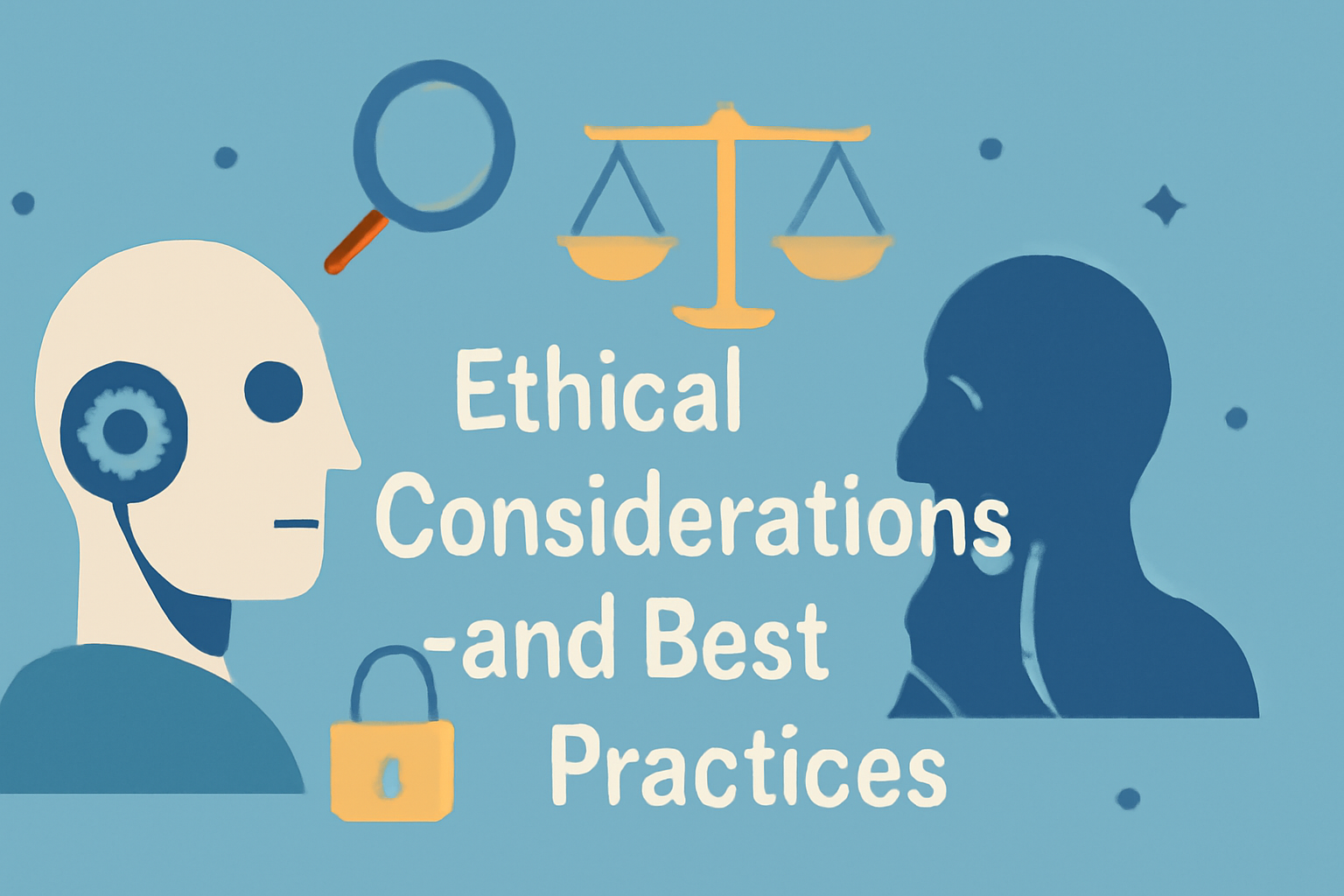
Data privacy and algorithmic bias pose serious ethical risks in AI-driven advertising. To mitigate these risks, marketers should:
– Audit AI Outputs Regularly: Conduct bias audits to uncover and fix discriminatory patterns. Tools like IBM’s AI Fairness 360 can help.
– Maintain Human-in-the-Loop: Always involve humans in critical decisions, such as final ad approvals and sensitive customer interactions. This oversight catches errors that AI might miss.
–Secure Data Handling: Follow GDPR and CCPA-compliant practices. Anonymize personal data before feeding it into AI models to avoid privacy breaches.
–Transparent Communication: Clearly inform consumers when AI personalizes content or recommends products. Transparency builds trust and reduces confusion.
By following these best practices, marketers can balance innovation with responsibility. They also reduce the risk of reputational damage and regulatory fines.
Future Outlook: Co-Existence or Replacement?
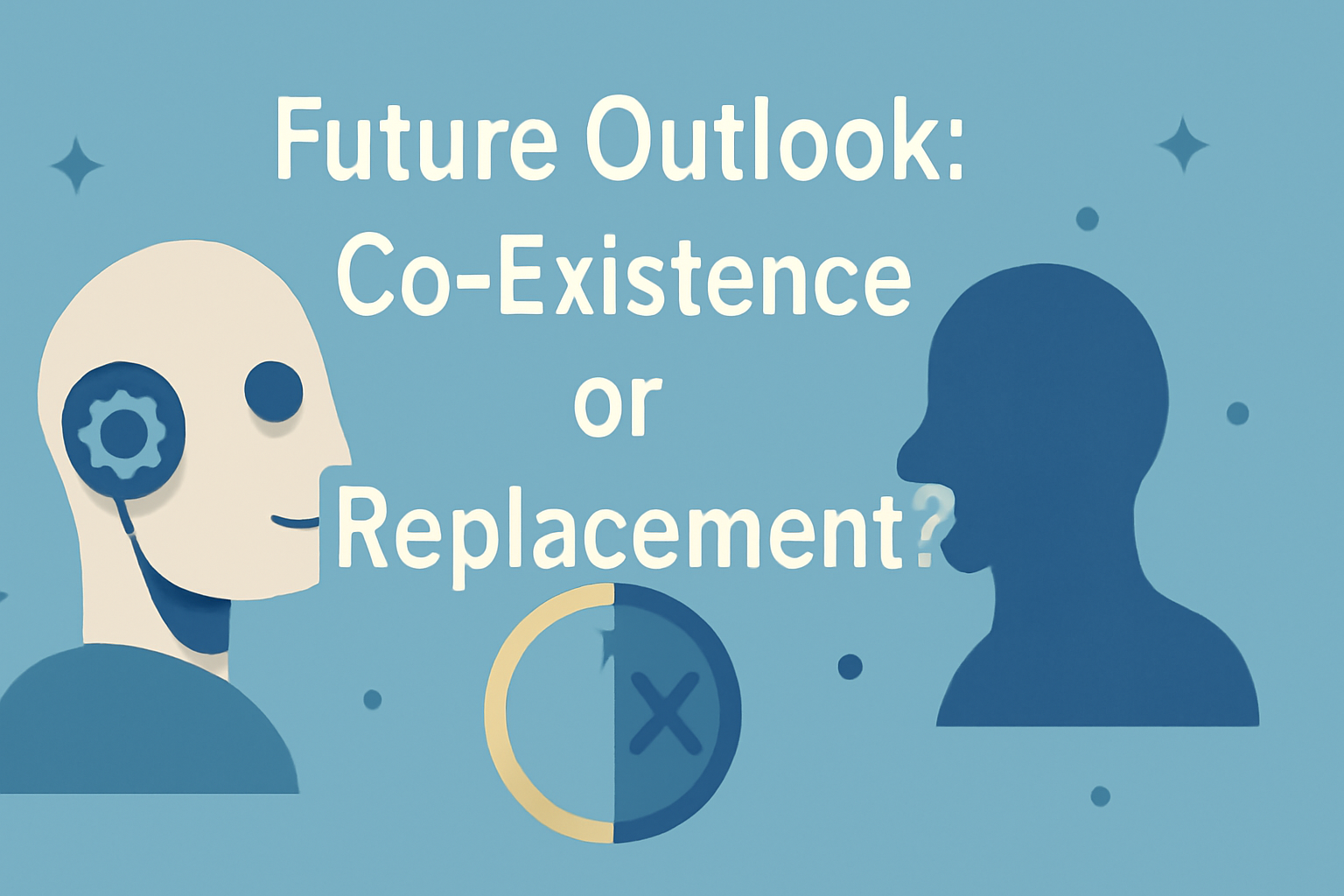
Industry forecasts indicate that AI in advertising and marketing will grow eightfold by 2027. This growth will transform roles rather than eliminate them. Gartner predicts that by 2026, 70% of enterprises will use generative AI in their marketing stacks. Consequently, personalization at scale will become standard practice. Forrester warns that, without strategic upskilling, 15% of marketers could see their roles change significantly due to AI-driven automation by 2028. Possible scenarios include:
–Augmented Roles: Marketers will team up with AI to boost creativity. Humans will focus on high-level strategy, while AI handles execution details.
–Niche Specializations: Growing demand for experts in AI ethics, data governance, and AI tool management will create new marketing career paths.
–Full Automation for Routine Tasks: Low-level roles such as basic data entry and simple A/B tests may become fully automated. Workers in these roles will need to reskill for more advanced tasks.
Overall, AI replacing marketing professionals wholesale is unlikely. Instead, a collaborative future emerges where human creativity and AI efficiency work hand in hand.
How to Get Started with AI in Your Marketing
1. Audit Your Current Tech Stack: Evaluate your CRM, email marketing platform, and ad networks for AI readiness. Identify quick wins, such as adding AI analytics to Google Analytics 4.
2. Pilot a Small AI Project: Choose a focused use case like using ChatGPT for social media ideation or Canva’s Magic Write for blog introductions. Then, track KPIs such as engagement rates and time spent on content creation.
3. Measure and Iterate: Define metrics (open rates, CTR, conversion lift) and run A/B tests comparing AI-assisted campaigns with traditional ones. Adjust tactics based on performance data.
4. Scale Gradually: When a pilot shows a clear ROI for example, a 12% increase in email revenue expand AI integration to other channels like programmatic ads and dynamic website content.
5. Invest in Training: Sign up for courses such as Google’s AI certification, HubSpot’s AI in Marketing, and Coursera’s AI for Everyone. Encourage collaboration between data scientists and marketing teams.
Select Beginner-Friendly Tools:
–ChatGPT: Ideal for ideation and drafting content (free tier available).
–Canva’s Magic Write: Great for generating blog intros and social media captions.
–Mailchimp’s AI Features: Offers automated send-time optimization and subject-line suggestions.
Starting with these steps ensures a low-risk entry into AI for digital marketing. Furthermore, measurable outcomes will guide your next moves.
Conclusion: Embracing AI Without Fear
AI in marketing isn’t a simple genius tool or a guaranteed job killer. Its real value lies in enhancing human skills, automating routine tasks, and enabling smarter decisions. By recognizing genuine concerns ethical, professional, and operational marketers can adopt AI responsibly. They can safeguard privacy, reduce bias, and maintain brand integrity with human oversight. In the end, the future belongs to those who view AI as a collaborator rather than a competitor. Upskill, experiment, and iterate to unlock AI’s potential while preserving the unique value of human creativity and strategic thinking.
FAQs
1. What are the main AI tools used in marketing today?
–HubSpot AI: Offers predictive lead scoring and AI-driven content suggestions for inbound marketing.
–Adobe Sensei: Provides automated ad optimization, dynamic creative generation, and personalized email workflows within Adobe Experience Cloud.
–Salesforce Einstein: Embeds AI across CRM to forecast sales, segment audiences, and optimize campaign timing.
–ChatGPT: Useful for brainstorming blog topics, social media copy, and email drafts; free tier available.
–Jasper AI: Specializes in long-form content, ad copy, and social posts with customizable brand voice.
2. Will AI replace my job as a marketing professional?
AI will automate routine tasks like data analysis, programmatic bidding, and basic A/B testing—but full replacement is unlikely. Instead, roles will evolve. Brands will rely on AI for efficiency while depending on humans for creativity and strategy. Today, 88% of marketers use AI daily, and only 9% of tasks have been fully automated. Most professionals upskill to work alongside AI tools. Gaining expertise in AI literacy, data interpretation, and strategic planning will keep marketers indispensable.
3. How can marketers start using AI without a big budget?
–ChatGPT Free Tier: Excellent for brainstorming ideas, drafting copy, and generating social captions.
–Google AI Features: Use Google Analytics’ AI-driven insights to spot trends and anomalies in website traffic.
–Mailchimp’s AI Tools: Free-level features include send-time optimization and predictive insights.
Follow a lean pilot process: set a clear goal (e.g., improve email open rates), pick an AI tool that aligns with that goal, measure results, and refine based on data.
4. What skills do I need to work with AI in marketing?
–Data Literacy: Translate AI-generated insights into actionable strategies.
–Basic Coding (Python/R): Useful for customizing AI models and collaborating with data scientists, though many platforms are low-code/no-code.
–AI Dashboard Familiarity: Navigate tools like HubSpot AI, Salesforce Einstein, and Adobe Sensei to set up and monitor campaigns.
–Critical Thinking: Question AI outputs, spot potential biases, and ensure alignment with brand messaging.
–Digital Marketing Expertise: Deep knowledge of SEO, social media, email, and paid ads is key for effective AI integration.
5. Are there ethical risks when using AI in marketing, and how do we mitigate them?
Ethical Risks:
–Data Privacy: AI often needs large datasets; mishandling can violate GDPR and CCPA.
–Algorithmic Bias: Without diverse training data, AI may reinforce discrimination in ad targeting and recommendations.
–Transparency Issues: Consumers may distrust brands that fail to disclose AI-driven personalization.
Mitigation Strategies:
–Obtain User Consent: Clearly explain data collection and AI usage, and secure opt-ins for personalized experiences.
–Audit AI Models: Use bias detection tools (e.g., IBM AI Fairness 360) and review regularly to find unintended discrimination.
–Human Review: Keep humans in decision loops for sensitive tasks like final ad approvals to catch errors and ensure ethical compliance.
–Diverse Training Data: Build inclusive datasets during model training to minimize bias and reflect varied consumer segments.
–Transparent Reporting: Publish AI use policies and offer users options to opt out of AI-driven personalization.
By following these steps, marketers can responsibly harness AI tools maintaining consumer trust while driving innovation.
At Balistro, we specialize in helping businesses grow through effective digital marketing strategies. From Google Ads to Meta Ads, we deliver data-driven campaigns that maximize your ROI and drive real results. If you’re looking to boost your online presence, generate leads, or scale your e-commerce business, our expert team is here to help. Contact us today to learn more about how we can support your advertising needs!

